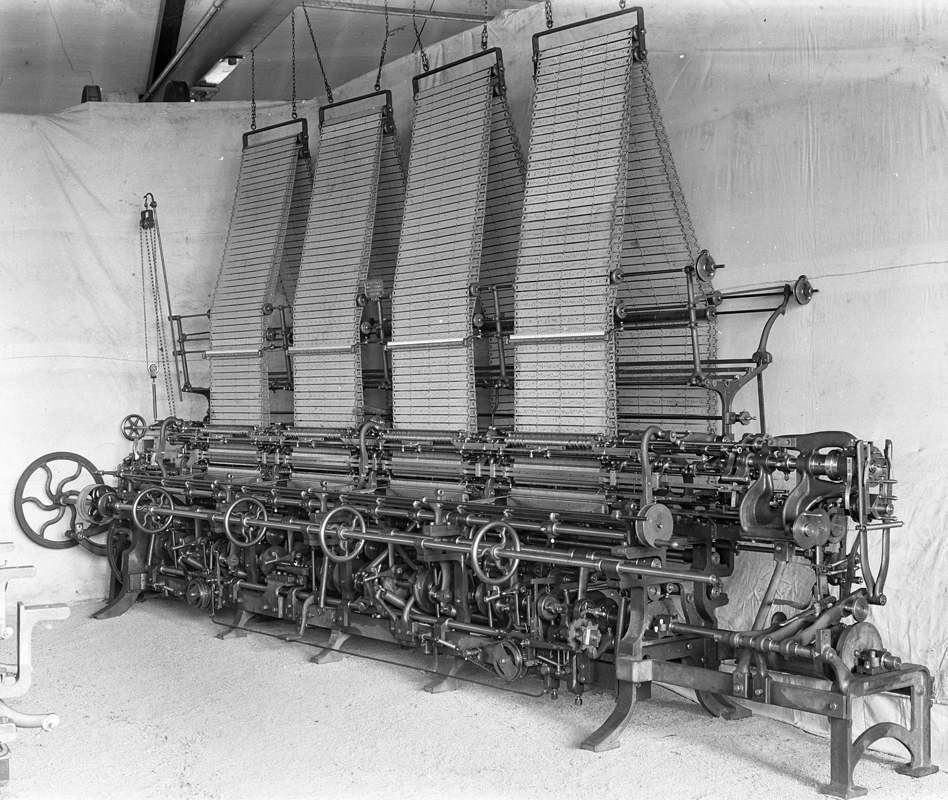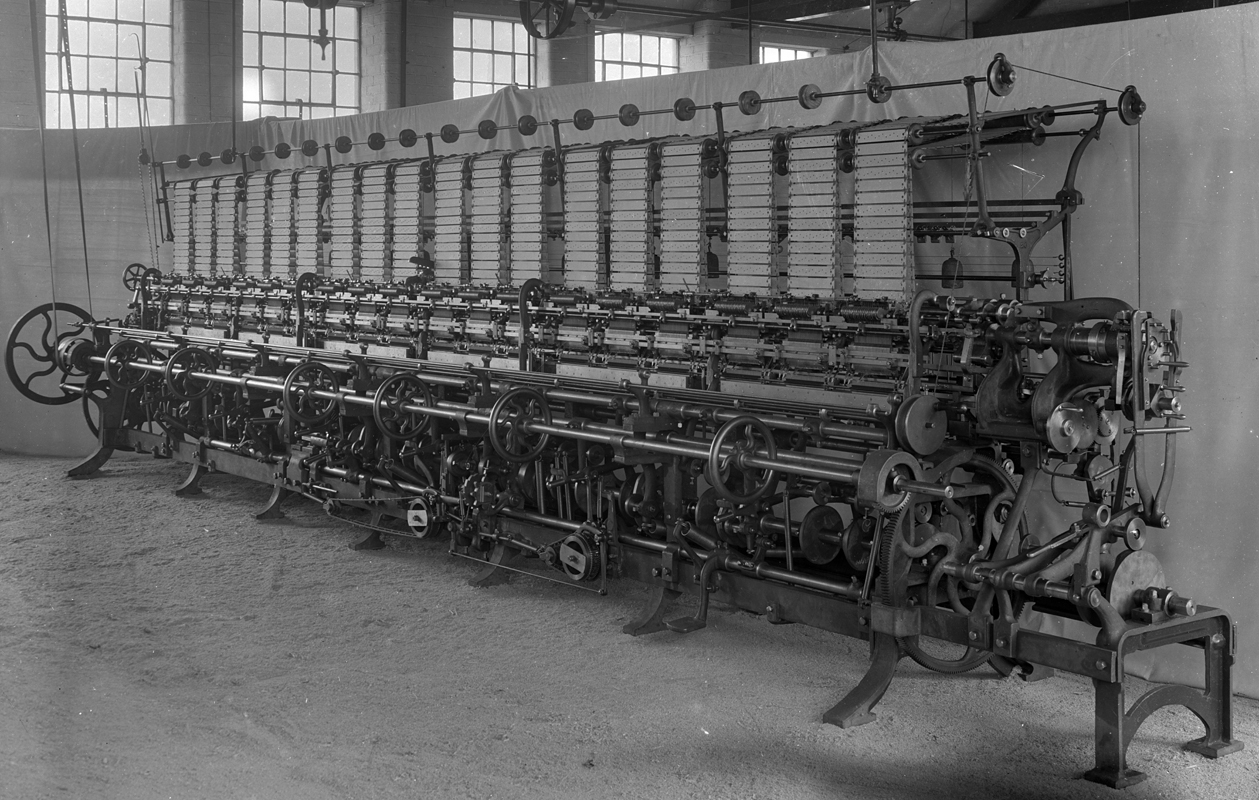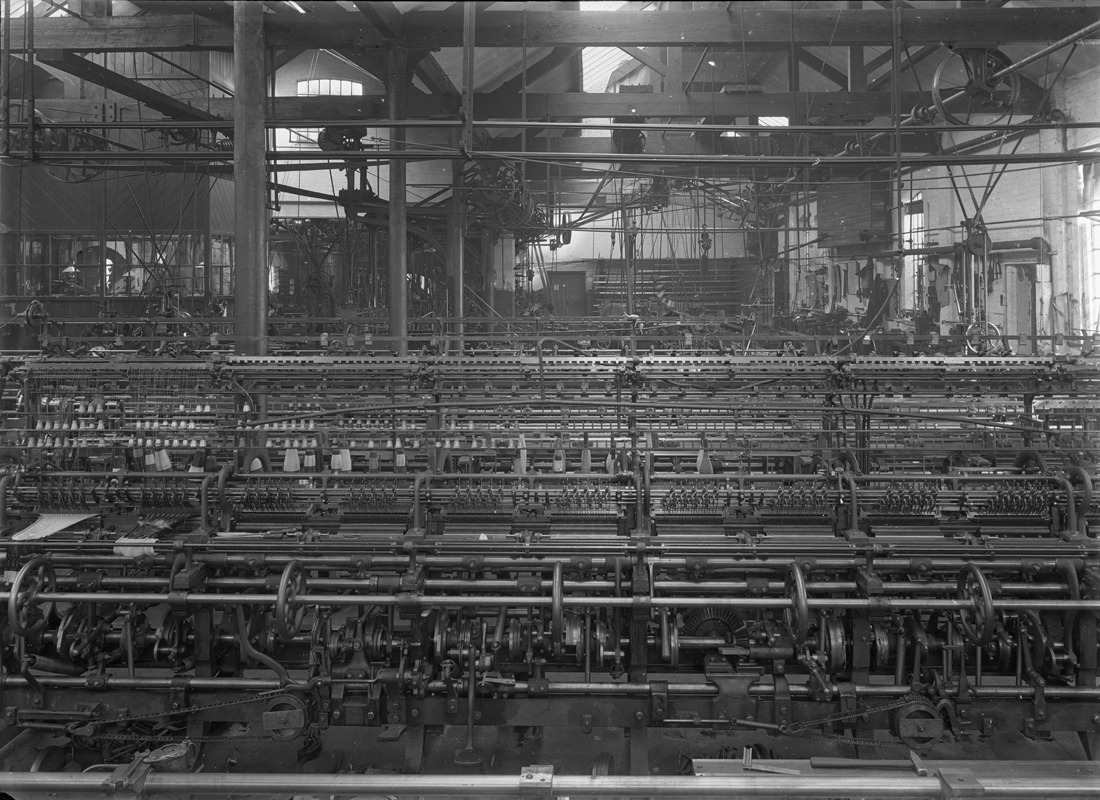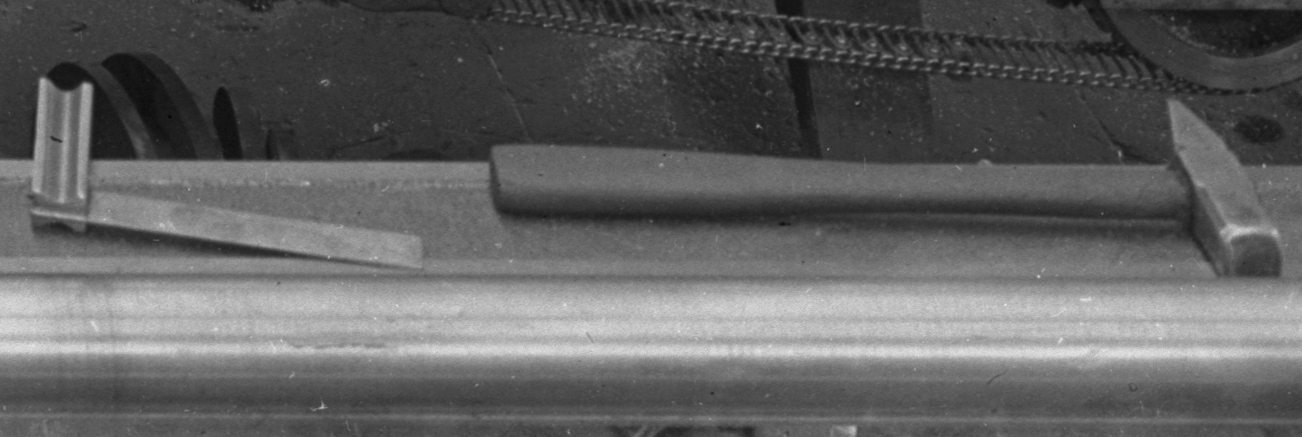Nottingham Industrial Museum
I'm volunteering at this vitally-important resource, housed in the former stable block of Wollaton Hall, the operation of which is being transferred to a charitable trust run by volunteers.
- More photo archaeology
- First, an impressive curtain lace machine. Although it has a curtain lace machine in store, the museum isn't able to display it because the ceilings are too low.
And here's another:
This is what photo archaeology is all about; a photograph of a crowded factory (though I haven't spotted any signs of sentient life):
(Above) Image the noise whan all these machines were in motion. Looks like the office in the far left corner.But look what I found...(Above) A row of vices along a workbench, with someone's overcoat hanging on the wall.(above) A well-worn hammer and a set square.(Above) And best of all, a spanner and a battered old oil can!
- Massive machines
- I've scanned, so far, about 20 boxes of negatives (about 400 photographs). Almost all are of machines. I have a feeling that the photographs were taken in the workshop to aid the re-assembly of the machines at their final destination. Here are a few examples:
This machine is worth a closer look...
 It bears a maker's plate: "Cotton's Patents (Hosiery Machinery) The Original Inventors and Patentees Wm. Cotton Ltd Loughborough England.
It bears a maker's plate: "Cotton's Patents (Hosiery Machinery) The Original Inventors and Patentees Wm. Cotton Ltd Loughborough England. - Ladies and Lathes
- Until now, most of the glass plates I've been scanning have been photographs of textile machines or parts of machines. However, during the First World War the lace factories changed from producing flimsy decorative materials to the manufacture of much more brutal products for the war effort.
In amongst an otherwise unremarkable box of plates I came across half a dozen photographs of working women, most of whom are pictured at lathes on which they appear to be turning shell cases.
 A female lathe operator stares qizzically at the photographer. She is standing at a belt-driven lathe in what looks to be a busy and crowded factory.In the lathe appears to be the sharp end of a shell case.
A female lathe operator stares qizzically at the photographer. She is standing at a belt-driven lathe in what looks to be a busy and crowded factory.In the lathe appears to be the sharp end of a shell case. A female lathe operator in the same facory, a fascinating, if frightening, mass of unshielded wheels and belts. Her protective clothing seems to be the only nod towards health and safety.
A female lathe operator in the same facory, a fascinating, if frightening, mass of unshielded wheels and belts. Her protective clothing seems to be the only nod towards health and safety. At her right hand, ranks of shell cases. To her left, an array of well-used tools. The mass of detail in this photograph is full of interest. One can imagine the noise of the lathes and other machinery, the belt drives, prhaps a steam engine in the background.
At her right hand, ranks of shell cases. To her left, an array of well-used tools. The mass of detail in this photograph is full of interest. One can imagine the noise of the lathes and other machinery, the belt drives, prhaps a steam engine in the background. - Day 5 onwards: Glass plates...
- Today I began using a simple card mask to position the negatives on the scanner platen. Although I had to remove it before making each scan, it did speed up the process a little, and avoided finger marks on both platen and negative (they are impossible to pick up using cotton gloves). The ideal would be a transparent mask that wouldn't have to be removed, but at the moment I don't have access to anything suitable. More machines...
- Plodding on through the boxes of glass negatives. The highlight
of today's session was the discovery of a "ghost". To separate
 the machine being
photographed from the cluttered background, the photographer had
several men hold up a length of fabric and shake it during the long
exposure, thus creating a grey blur. However in this shot you can make
out the head and cap of one of the assistants! It is good to see a
human being after so many chunks of machinery, but also slightly eerie,
considering that this anonymous man has been dead for probably
seventy years or so! The machine, by the way, was a Cotton's Patent
Knitting Machine manufactured in Loughborough.
the machine being
photographed from the cluttered background, the photographer had
several men hold up a length of fabric and shake it during the long
exposure, thus creating a grey blur. However in this shot you can make
out the head and cap of one of the assistants! It is good to see a
human being after so many chunks of machinery, but also slightly eerie,
considering that this anonymous man has been dead for probably
seventy years or so! The machine, by the way, was a Cotton's Patent
Knitting Machine manufactured in Loughborough.
- Today I began the mammoth task of scanning hundreds of 6.5in x
4.5in glass plate negatives, using a scanner in the museum office
housed in what was once Nottingham Corporation Waterworks depot at the
foot of the castle. It's a rather tedious process, each scan taking in
all about five minutes, but I am able to work on my laptop at the same
time. The detail on the photographs is fantastic. Many have small
labels, the meanings of which are at the moment a mystery.

- Day 2: Letters...
- Spent this morning being shown more of the museum stores, crammed
with masses of mysterious machines. But for me the real excitement came when I
was sorting through some files and came across a folder marked
"Working Lives, General." Inside were 41 letters written in 1973 in
which the writers described their first days at work. The writers had
been born in the late C19th and early C20th, and are all certainly now
dead, so the contents of the letters are oral history written down.
I've volunteered to transcribe and research the collection, and you'll
read more about them here.
- Day 1: bicycles...
-
It was a slightly disorganised start. Keys were missing, and the materials we had been supposed to be using were locked away somewhere inaccessible and replacements would take a while (the joys of health and safety - in the bad old days we used Indian ink and clear nail varnish, probably shredding our lungs or something). So instead we wrote condition reports on some bicycles that were probably to be moved from the stores to the museum display to replace others that were being returned to their owner.
The first was a Bickerton folding bicycle from the 1970s, probably never ridden, so in good condition apart from that speckle of corrosion that aluminium often acquires. As it had never been used, it was stiff to fold together, and even stiffer to fold up again, and we never did work out how to achieve its correct folded state (there was of course no manual, and not much help online) so the procedure was going to need further research.
Then we moved into the pigeon-dropping splattered storeroom know as "The Dovecote" where, surrounded by a motley collection of bikes ranging from the decrepit to some 1980s prototypes, we examined a fine old New Hudson tandem from the 1930s that not only had seating for a lady at the rear (a "ladyback") but its double frame could be unbolted so the tandem could be transformed into a single-seater bicycle. A great piece of design. Despite not having been ridden for a long time, this bike looked as though, with a bit of elbow grease and some new saddles, tyres and brake and gear cables, it could be restored to working order.
Finally we looked at a Raleigh small wheel bicycle (SW16), one of a range popular in the 1980s, which, if its tyres were inflated, could probably be ridden without further ado. I liked its integral lights, powered by a dymohub. Perhaps the most interesting part of the day was a quick peek into the area of stores known as "Barlow's Flat" after a lady who once lived in this suite of uneven-floored rooms above the stables. Over the years a random selection of material has been dumped here, and we peered at tantalising piles of photographs, drawers full of maps and plans and a room filled with unlabelled boxes mysteriously shrouded in black plastic the contents of which are unknown.
Plenty of work for the near future!







